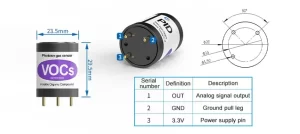Air pollution is a significant global concern that affects human health, the environment, and climate change. Monitoring air quality is crucial to identify pollutants, assess their impact, and implement effective mitigation strategies. Gas sensors play a vital role in air quality monitoring by detecting and quantifying various gases present in the atmosphere. In this article, we will explore how gas sensors can be used in air quality monitoring and their significance in ensuring cleaner and healthier environments.

Detection of Pollutant Gases:
Gas sensors are capable of detecting a wide range of pollutant gases, including carbon monoxide (CO), nitrogen dioxide (NO2), sulfur dioxide (SO2), ozone (O3), volatile organic compounds (VOCs), and particulate matter (PM). These sensors provide real-time measurements of gas concentrations, allowing for immediate identification of potential air pollution sources and hotspots.
Indoor Air Quality Monitoring:
Gas sensors are widely used for monitoring indoor air quality in residential, commercial, and industrial settings. They help identify harmful gases released from building materials, heating systems, cooking appliances, and other indoor sources. By continuously monitoring indoor air quality, gas sensors enable the implementation of ventilation strategies and pollutant control measures to ensure healthier indoor environments.
Outdoor Air Quality Monitoring:
Gas sensors are deployed in outdoor air quality monitoring networks to measure pollutant concentrations in urban, industrial, and rural areas. These sensors are typically integrated into fixed monitoring stations or mobile monitoring platforms. By collecting data on pollutant levels, gas sensors assist in assessing compliance with air quality standards, identifying pollutant sources, and evaluating the effectiveness of pollution control measures.
Early Warning Systems:
Gas sensors can be utilized in the development of early warning systems for air pollution events. By detecting sudden increases in pollutant concentrations, such as during forest fires or industrial accidents, gas sensors can trigger alerts and emergency response actions. This early detection enables authorities to take swift measures to protect public health and minimize the environmental impact of such events.
Industrial Emission Monitoring:
Gas sensors play a critical role in monitoring emissions from industrial facilities, power plants, and manufacturing processes. These sensors help measure and track pollutant levels to ensure compliance with emission regulations. By providing accurate and real-time data, gas sensors assist in optimizing industrial processes, minimizing pollutant releases, and improving overall air quality.
Mobile Air Quality Monitoring:
Advancements in gas sensor technology have led to the development of portable and wearable devices for personal air quality monitoring. These devices allow individuals to assess their exposure to pollutants in real-time and make informed decisions regarding their activities and locations. Mobile gas sensors also enable citizen science initiatives, where individuals contribute to large-scale air quality monitoring efforts.
Urban Planning and Policy Making:
Gas sensors provide valuable data for urban planners and policymakers to understand the spatial and temporal patterns of air pollution. By mapping pollutant concentrations across cities, gas sensors help identify areas with poor air quality and potential health risks. This information can guide the development of effective pollution control strategies, land-use planning, and policy interventions to improve air quality in urban environments.
Integration with IoT and Data Analytics:
Gas sensors can be integrated into Internet of Things (IoT) platforms to create comprehensive air quality monitoring systems. IoT-enabled sensors collect data in real-time and transmit it to centralized databases for analysis. Advanced data analytics techniques can then be employed to identify trends, patterns, and correlations between pollutant levels and various factors such as weather conditions, traffic patterns, and industrial activities.

Conclusion:
Gas sensors are indispensable tools in air quality monitoring, enabling the detection, measurement, and analysis of pollutant gases. Their applications range from indoor air quality monitoring to outdoor pollution assessment, industrial emission control, early warning systems, and urban planning. By utilizing gas sensors, governments, organizations, and individuals can make informed decisions, implement effective pollution control measures, and work towards creating cleaner and healthier environments for present and future generations. Continuous advancements in gas sensor technology and data analytics will further enhance our ability to monitor air quality and combat the global challenge of air pollution.
 : +86 155 8830 2704
: +86 155 8830 2704 : jxdziot@gmail.com
: jxdziot@gmail.com
